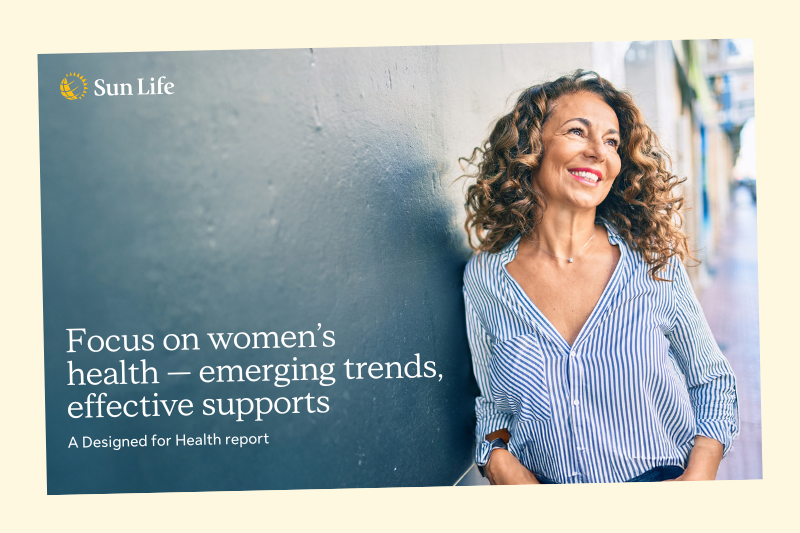Women under 50 are being diagnosed with cancer at twice the rate of men in the same age group, according to new health claims data from Sun Life that analyzed more than 3 million plan members and 20,000 employers across Canada.
The report, titled Focus on Women’s Health — Emerging Trends, Effective Supports, found breast cancer is the primary driver of the gender gap in cancer diagnoses among younger workers. Breast cancer incidence among women aged 20 to 29 increased 45.5% between 1984–1988 and 2015–2019, from 3.9 to 5.7 cases per 100,000.
“Cancer rates for women under 50 are twice as high as men in the same age group,” said Marie-Chantal Cote, senior vice-president of health at Sun Life, in a conversation with HR News Canada. “The number one reason for that is breast cancer.”
The findings come as some provinces recently lowered the age for covered breast cancer screenings to 40, according to the report, reflecting growing concern about early-onset cases.
Chronic disease hits younger women harder
Sun Life’s analysis also revealed women’s drug claims for diabetes are growing 40% faster than men’s between 2019 and 2024. Among employees under 30, diabetes and high blood pressure drug claims for women significantly outpaced men’s by 2024, despite similar levels in 2019.
Cote said hormonal fluctuations may partly explain the trend.
“Diabetes reduces the protective effect of estrogen against cardiac disease in premenopausal women,” she said, citing research showing women with diabetes face up to 50% greater risk of heart disease compared with men who have diabetes.
The data showed women aged 40 to 59 — a key demographic for employers given their experience and leadership roles — had the highest rates of migraine drug claims. Women’s migraine claims were four to five times higher than men’s across all age groups.
“Fourteen per cent of Canadians experience migraines,” Cote said. “Sometimes people think, well, it’s a headache and you take Tylenols and you feel better. But there’s a variety of very disabling symptoms.”
Mental health and caregiving strain
Women accounted for 45% of long-term disability claims related to mental health disorders, compared with 33% for men, according to the Sun Life data. Depression drug claims were also significantly higher among women and showed strong growth between 2019 and 2024.
Cote said caregiving responsibilities contribute to the mental health gap. Sun Life research conducted with the Canadian Association of Retired Persons found 43% of women caregivers reported significant stress from their caregiving role, versus 26% of men. Women were twice as likely as men to say caregiving made taking care of their own health very challenging.
“There’s still a lot of pressure,” Cote said. “There’s still some extra burden on women.”
Benefits coverage often underutilized
Cote said many employees don’t realize what their group benefits plans already cover for conditions like cancer, migraines, diabetes, and menopause.
For breast cancer specifically, plans can cover prosthetics, wigs, cold cap therapy to reduce hair loss during chemotherapy, mental health support, and drug coverage. Health spending accounts and personal spending accounts can also help cover related expenses.
“What it requires, and that’s what we all want to collectively do more of, is help people navigate their plan based on their unique need, as opposed to knowing everything about your plan and then trying to figure out what to do,” Cote said.
She said communication is critical. “People don’t always know what’s available in their plan,” she said, noting stigma and lack of discussion around conditions like menopause and women’s reproductive health compound the problem.
Menopause and workplace impact
The report highlighted menopause as a significant but often overlooked workplace health issue. More than 5 million Canadian women over 40 are in the workforce — about one-quarter of all workers — and many are in leadership roles during perimenopause or menopause.
Cote said Sun Life analyzed drug claims from more than 13,000 women over 40 who began menopause hormone therapy. Claims for heart disease and diabetes drugs increased significantly in the three years before women started menopause medication, with blood pressure drugs showing the strongest growth.
“We’re seeing also a growth in 30 to 39 and 40 to 49, but the real growth is in the age group 20 to 29,” Cote said of breast cancer incidence.
According to the Menopause Foundation of Canada, an estimated one in 10 women will leave the workforce due to unmanaged menopause symptoms. Cote said employers can help by offering education, ensuring robust benefits coverage, and creating inclusive policies.
“There’s nothing wrong about talking about menstruation and menopause and fluctuation in hormones in an educative way, using the right language, being supportive,” she said.
Climate change as emerging health risk
The report also examined how climate change and extreme weather events affect women’s health. Sun Life surveyed working Canadians and found women were more likely than men to report climate-related physical and mental health impacts.
Among employees with chronic conditions, 30% of women said climate change or extreme weather made their condition worse or more difficult to manage, compared with 24% of men.
“Women are more often at a pre-existing social and economic disadvantage, making it more difficult to mitigate climate impacts,” Cote said. “Women are also often responsible for caring for others, such as children and elderly parents. This can reduce self-care and increase stress.”
Employer actions
Cote recommended employers communicate available supports clearly, offer flexible work arrangements, and consider adding virtual care services to reduce barriers to accessing mental and physical health care.
“Organizations continue to be purpose-driven and be mindful,” she said. “Safe cultures, comfortable speaking up, comfortable exchanging is always something we strongly encourage.”
She said the goal is to help employees understand what benefits apply to their specific situations. “There’s no one size fits all in an organization,” Cote said. “The more you talk about it, the more people realize, ‘Oh, you mean we have a program for that, oh, we have a policy for this.'”
Sun Life’s report is part of its Designed for Health series and draws on claims data from more than 20,000 employers and over 3 million plan members, along with recent research on women’s health, caregiving, and climate impacts on workplace health.







